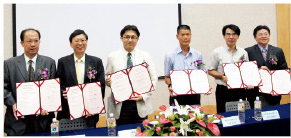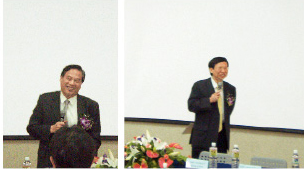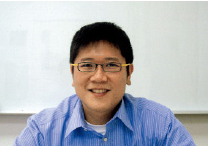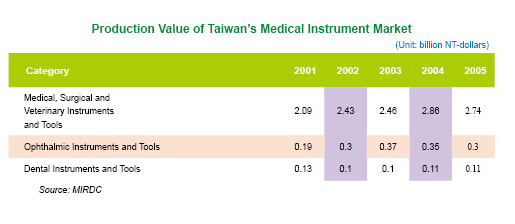Veterinary Surgical Instrument R&D Alliance to Create Synergy
2010/01/13 | By Steve ChuangThe Veterinary Surgical Instrument R&D Alliance was officially inaugurated on July 15, 2009 to further develop Taiwan-made surgical tools.

With the Department of Industrial Technology under the Minister of Economic Affairs commissioning the MIRDC (Metal Industries Research & Development Centre) to form the alliance, the team is made up of the leading hand tool makers in Taiwan-K&W Tools Co., Ltd., Kuang Yuang Industrial Co., Ltd. and Top Well Tools Industrial Co., Ltd., and the National Veterinary Hospital, and a top-notch veterinary medicine department at the National Chung Hsing University (NCHU).
Founded in 1973, K&W is a seasoned hand tool maker on the island, supplying a full range of saws; while Kuang Yuang, established in 1972, is a bellwether forging company, turning out a variety of wrenches and pliers of forged stainless steel. Equally influential as the two peers in their respective fields, Top Well has been a well-known supplier of nippers and universal pliers since its inception in 1982.
The six-member alliance, including the MIRDC, will be working closely with NCHU's Veterinary Medicine Department's Animal Disease Diagnostic Center, agreeing to develop, promote Taiwan-made veterinary surgical tools.
Existing Partnership
NCHU president Dr. Shaw Jie-fu said at the inauguration that the alliance between industry and the university is expected to help foster the development of veterinary surgical tools, because NCHU, in Taichung of central Taiwan, is amid a cluster of hand tool makers and has been helping such makers to upgrade production and products for years, hence already building a close industry-academic partnership.


Dr. Shaw also stressed that the NCHU will willingly share resources with the alliance, saying "NCHU's veterinary medicine center is the first and only in Taiwan, hence being able to be the most reliable experimental, research support. Above all, experience derived from the alliance will motivate the NCHU to engage in inter-sector cooperation in Taiwan in the future."
Citing the U.S. as an example, Frank Mao, chairman of Veterinary Medicine Department, pointed out that only 2.5% of the total medical spending recognized under national health insurance nationwide is for pets. But with higher pet ownership, the proportion is estimated to rise to 6% soon.
"The pet economy has been growing worldwide and in Taiwan that has made veterinary medicine increasingly important, as well as assure huge business potential for veterinary instruments, such as surgical tools," said Mao, concluding that working with Taiwan's only veterinary medical center is an ideal strategy for Taiwanese hand tool makers to carve out niches in high-end tools.
Aldous Chao, general manager of K&W, also mentioned that his firm began to develop, produce surgical tools about 5 years ago, hoping to turn out in-house products fully meeting international standards. "Through the alliance, we expect to sharpen our competitive edge in both production capability and distribution skills to go global as our ultimate goal," he says confidently.
First of Its Kind
The formation of the alliance has been partly made possible by Matt Yang, project manager of MIRDC's Promotional Office to Revitalize Traditional Industries, who has spent considerable effort to lobby to bring together these heavyweights, a first such partnership of its kind in Taiwan.
Experienced in advising traditional manufacturers on production upgrades, Yang is very optimistic about Taiwanese hand tool makers' potential to tap the surgical tool market, indicating that it is essential for the hand tool sector in Taiwan, a top-five exporter globally, to build sustainable development and raise added-value in products by upgrading capability, especially when emerging rivals in countries are increasingly becoming a threat.


"In 2008, Taiwan exported hand tools worth NT$56.09 billion (US$1.699 billion at US$1: NT$33), mostly of socket wrenches, wrenches, tool sets and screwdrivers," he says. "But the average unit price was only US$6.5 per kilometer, only one-third that of Germany and Japan. Years of being exclusively OEM (original equipment manufacturer) have trapped Taiwanese makers in fierce price competitions against Chinese and southeastern Asian makers."
To assist the traditional industry to raise product value through development of high-end products instead of simply raising output volume, Yang noted that the MIRDC has been working with a couple of makers to develop digital tools, smart power tools and surgical tools by applying innovative metals in production, saying "We have targeted surgical tool development for a while, mainly because there truly exists a huge market worldwide."
Citing statistics compiled by Philip M. Parker, a chaired professor of INSEAD, Yang mentioned that there is an estimated US$118.986 billion in worldwide market potential for manufacturing medical, surgical, ophthalmic and veterinary instruments (excluding electrotherapeutic, electromedical and irradiation apparatus) in 2009, with Asia to absorb a 30.9% share, Europe 26.5% and North America and the Caribbean 23.8%. "The scale of the market will keep growing at 4% on average, with the production value to hit US$134 billion in 2012, according to the INSEAD survey," he says. "Obviously, here is a real Blue Ocean for Taiwanese makers, but not a will-o'-the-wisp as on the desert," he says.
Lack of Brand Recognition
The MIRDC has been commissioned by the Industrial Development Bureau (IDB) of the MOEA to carry out the "Metal Industries Competitiveness Enhancement Project" since 2007 to assist Taiwanese metal product industries, with the development of competitive, innovative hand tools on its R&D list.
Aided technically by the MIRDC, K&W has developed a variety of surgical tools, including reamers for femurs and tibias, bone cutter and saw blade sets and intramedullary nails for total knee replacement surgery, all of which meet FDA (Food and Drugs Administration) standards, and even setting up mass-production technologies for such products. Besides, the company and MIRDC jointly attended MEDICA, the world's largest trade fair for industries of medicine and medical instruments in Dusseldorf, Germany, in 2008, to tap the global market.
But, Yang said, progress has not been smooth as expected, as the market for general surgical tools is "monopolized" by major international suppliers. One main reason is that hospitals buy and trust well-known brands-which is also true in Taiwan. "After all, patients' health hinge on the quality of such tools," said he. "Therefore penetration into the market is blocked by lack of brand recognition."
Opening a Door
Fortunately, veterinarians in Taiwan, Yang stated, is giving hope to the MIRDC and the hand tool alliance by opening a door.
A couple of positive and practical factors back their decision to switch their focus to the segment in Taiwan as a strategic step. First, veterinary surgical tools are not as strictly regulated as those used for humans. For example, they don't need to be GNP certified in Taiwan, according to Yang. Second, the segment has about NT$3 billion (US$90.9 million) in demand yearly, and without being dominated by large distributors makes the market more accessible by newcomers.
Besides, Yang also mentioned that the number of veterinarians in Taiwan increases by 200, or 5%, yearly, securing stable end-user demand for surgical tools on the island, saying "Aiming at specific end-user demand allows makers to customize products efficiently and effectively, generating higher margins than standardization." In addition, he added, most veterinary surgical tools are functionally similar to those for humans, making it easier for makers to upgrade production capability.
Practical and Feasible
"Therefore," Yang said, "working with the NCHU to develop medical instruments is practical and feasible for hand tool makers, which is why we worked hard to push forward the formation of the alliance."
As a member of the alliance, Kuang Yuang specializes in supplying forged stainless steel, the major material for medical tools that must be antibiotic, corrosion and erosion resistant, as the upstream supplier, while the other two members K&W and Top Well manufacture veterinary surgical saws, pliers and scissors, all of which will be sent for quality testing by the MIRDC, NCHU and quality assurance institutes, and then packaged, sold to the National Veterinary Hospital.
Based on real-world clinical feedback from the National Veterinary Hospital, the MIRDC and NCHU will work with makers to kick off R&D to continuously hone tools to find optimal solutions. "This is a positive operational model, with the three makers turning out tools, the MIRDC and NCHU helping to upgrade products, and the National Veterinary Hospital as buyer and user," Yang concludes. "Besides, we will also participate in more global medical instrument exhibitions, in hopes of impressing foreign buyers with our competitive products to build exposure."




